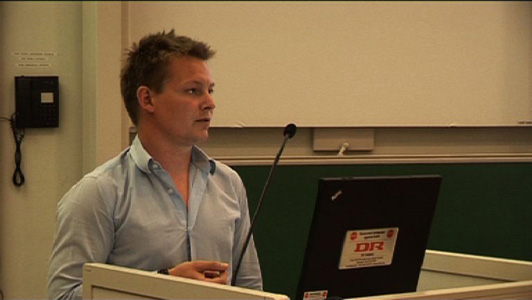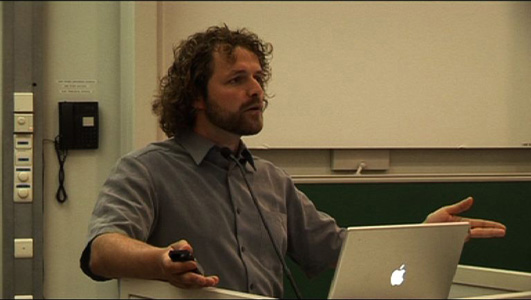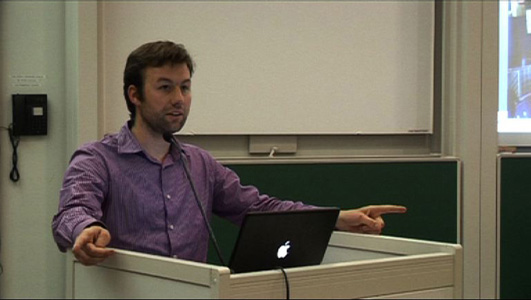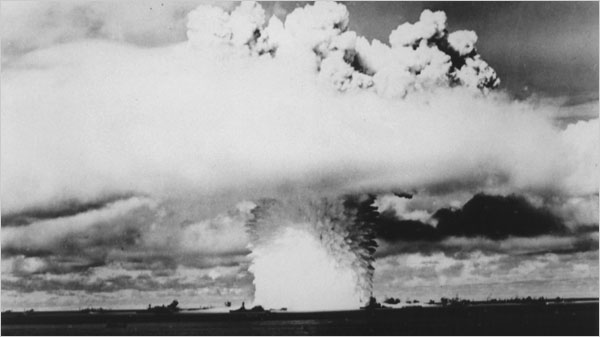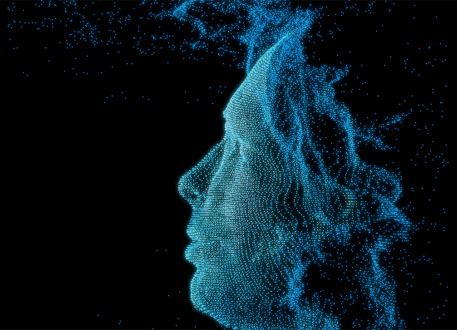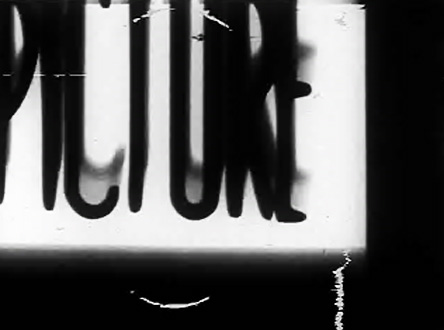
“Interruption is one of the fundamental methodes of all formgiving. It reaches far beyond the domain of art. it is, to mention just one of its aspects, the origin of the quotation. Quoting a text implies interrupting its context”.
— Walter Benjamin
When we were asked to compose some film programs on the recycling and re-ordering of “found footage” (‘Ghosting the image‘ and the forthcoming program ‘The Order of Things’), the initial idea was to show a selection of “avant-garde” and experimental works we find vital and relevant, while trying to plug into contemporary tendencies of remix and simulacra, in the institutional world of visual arts as well as internet culture. As we would find out however, there is a set of whole different ballgames here. Perhaps not surprisingly, we had a really hard time fitting works from these distinct (?) tropes of cultural and artistic production into what seemed to us as reasonably consistent and coherent programs. Here are some loose notes and quotes in which I try to track and relate some ideas, strategies and motives of cinematic appropriation and interruption. The selection of works and filmmakers/artists/producers I dwell on is entirely subjective. I added some video documentation, although quality (and context) is in most cases of course not at all how it should be.
There has been a practice of recuperation and recovery of moving images since the beginning of cinema. In journalism and traditional documentaries archival footage is mostly used as a form of quotation or evidence, as “a sacrament towards the hallowed ground of ‘objectivity’” (Joel Katz) – a notion that is in itself highly problematic. The rather naive idea that archive clips could be seen as historically neutral documents is countered by the work of a broad variety of filmmakers/artists, either working on a meta-level of inquiry of history and representation or reflecting on the cinematographic apparatus, in any case looking for ways of resisting or questioning the power’s projection of image. In the traditions of so-called “avant-garde’ or “experimental” cinema appropriation and interruption of existing images has become a common practice. Filmmakers use discarded scraps of adverts, B movies, newsreels, educational material and home movies to make new works, sometimes driven by economic necessity, but mostly as a result of decisions based on aesthetic and/or ethic viewpoints. In a way, a lot of these filmmakers can be considered as archaeologists, excavators of the layers of histories that resonate within the images, but at the same time they can act as subversive interventionists, diverting its original messages so that hidden histories and meanings are revealed – digging under the homogeneous surfaces of cinema and massmedia, leading to a self-conscious and critical viewing of the represented images and its intentions. The idea and use of traces and fragments, “leftovers,” is of course axiomatic of art in the twentieth century. Think of Schwitter’s, Hannah Hoch’s and Max Ernst’s collages at the beginning of the modern period or Warhol, Rauschenberg, and Popism postwar. Arguably the first film that uses found footage in a creative, non linear way is Joseph Cornell’‘s Rose Hobart (1939). Cornell, who was first and foremost a collector, is best known for his beautiful “boxes” – small assemblages constructed mostly from found materials and various ephemera. Drawing on the collage techniques that were in fashion at that time (especially in Europe), Cornell proposed a somewhat more nuanced and understated approach to the surrealist mode than many of his contemporaries. Rose Hobart is constructed almost entirely from footage refashioned from the 1931 jungle B-movie East of Borneo, starring the titular actress. Cornell removed virtually every shot that didn’t feature her, as well as all of the action sequences, and added a few pieces of nature films. The resulting film was then projected through a deep blue filter, at “silent speed” (that is, at a slow speed typically used to project silent films) and accompanied by the sounds of a kitschy record Cornell apparently found in a junk store (Nestor Amaral’s ‘Holiday in Brazil’), transforming the 77-minute feature into a 20-minute dreamlike love letter to the actress, but also a homage to “the profound and suggestive power of the silent film to evoke an ideal world of beauty, to release unsuspected floods of music from the gaze of a human countenance in its prison of silver light” (as Cornell wrote himself in a piece on Hedy Lemarr). Annette Michelson describes the effect of the film beautifully:
“Rose Hobart moves with the splendour of Gradiva, enveloped in a silence intensified by music, through a landscape decomposed, a space distilled, into a blue inane”.
-
Joseph Cornell, Rose Hobart (1939)
As the story goes, Salvador Dalí attended the premiere of the film in 1936 in NY, and halfway through the film overturned the projector and shouted, “Salaud!”. He claimed that Cornell stole the film from his subconscious. It was as if, he insisted, Cornell had stolen the film from his head before he had a chance to make it himself. Be it as it was, Rose Hobart certainly had a profound impact on a lot of avant-garde filmmakers, Ken Jacobs being one of them (he was once a assistent of Cornell). Here’s a quote from an interview with P. Adams Sitney:
‘I was seeing Jack [Smith] again and I told him, “Jack, you’ve got to see this movie.” We looked at it again and again, and we were both knocked out. Jack tried to act at first like a little bit removed, like I was overstating it, and then he broke down and said, “No, it’s very good.” We looked at it in every possibly way: on the ceiling, in mirrors, bouncing it all over the room, in corners, in focus, out of focus, with a blue filter that Cornell had given me, without it, backwards. It was just like an eruption of energy and it was another reinforcement of this idea I had for making this shit film [Star Spangled to Death] that would be broken apart and then again there would be an order.’
Ken Jacobs is one of the most visionary filmmaker that would elaborate on these ideas of fragmentation and interruption, tampering with linear narrative through isolation, reconfiguration, repetition and reimagining of continuity. Star Spangled to Death is his magnus opus, a monumental, seven hour epic that has taken nearly fifty years to complete (1957-2004). Footage of his own, mostly of darkly humorous street
performances by Jack Smith and Jerry Sims, is combined with fragments from documentaries, cartoons, musicals and educational films, as a social criticism of the U.S. which, in his words, is “stolen and dangerously sold-out”. Jacobs (who is, so he says, split between painting and cinema) describes his aesthetic as one based around a certain kind of interruption, a process he used to counteract the penchant for order, exploring the vitality and truth of fractured, failing audiovisual motives. Jacobs notes:
“I had a terrific bent towards a barren dynamic perfection. I was leaning toward a work like Mondrian would make. At the same time, these perfect structures, I knew were not right. I felt that their destruction revealed more of a truth than their standing perfection – Just watching things break, and in their breaking reveal their structure, had the most vibrant moment of life… I was interested in revealing things in their breaking and I wanted Star Spangled to Death to be a film that was constantly breaking.”
-
Ken Jacobs, Star Spangled to Death (1957-2004) excerpt
“Making works that displayed mechanism, emphasizing tension between means and appearance was Modernism, and political inasmuch as it shared in the historical move to demystify power’s projection of image, aka The Toto (pull-back-the-curtain) Effect. (…) Cinema for me would remain a playing on the margin of illusion and its imminent collapse into evident means, the drama of a tottering pretense, without the anxiety-addiction we celebrate as story (an unconvincing story would be okay, with the audience having to actively make-believe). The last thing I wanted a viewer to be thinking about was what was going to happen next and will Happy Ending arrive on time. No suspense! Only the now, as with paintings, with beginnings and endings far from one’s thoughts.”
-
Ken Jacobs, Tom, Tom the Piper’s Son (1969-1971) excerpt
Two other early adopters of cinematic strategies of interruption were Bruce Conner and Arthur Lipsett (see also earlier posts). While the latter developed his aesthetics from experimenting with sound (Lipsett’s first film Very Nice, Very Nice (1961) started out as a soundcollage and developed into, in Stanley Kubrick’s words, “one of the most imaginative and brilliant uses of the movie screen and soundtrack I have ever seen”), Conner had been making visual collages since high school, influenced by the legacies of surrealism, constructivism and dada – movements that had already been challenging conventional assumptions about the nature of representation in art, while at the same time radically dispensing with principles of coherence and organic unity. Encouraged by filmmakers such as Larry Jordan and Stan Brakhage, Conner started making movies in the late 1950’s. His debut, A Movie (1958) was one of the first real “collage” (although Conner himself prefered the term “montage”) film, based on a variety of found footage, both detritus and images with an “iconic” status, represented in a new context, vieled with layers of speculation, revelation, subjective evocation and poetic ambiguity. His premise was to look at the everyday in order to discover meanings that are denied or repressed:
“If you want to know what’s going on in a culture, look at what everybody takes for granted. Put your attention on that, rather than on what they want to show you. I view my culture here in the United States as I would regard a foreign environment. That is, it’s supposed to be my culture. I don’t feel that way.”
Like the visual art movements before him, Conner deployed his practice in the service of understanding the cultural and social significance of his materials, taking up the random, the aleatory, the unconnected and chaotic in order to make meaning of ourselves and the world that we find ourselves in – an urge that was also apparent in Conner’s other work (assemblage, photos, sculptures, paintings,.. ): to glue “the world down and make it mine”. To him, his films were no fantasies, but the “real world”, informed by the language of interruption and compression which characterises the delivery of most commercially driven television and cinema.
“My films are the ‘real world’. It’s not fantasy. It’s not a found object. This is the stuff that I see as the phenomena around me. At least that’s what I call the ‘Real World’. We have ‘Reality Shows’ presented to us regularly. The most prevalent one is the five minutes ‘reality show’ – the five minute news. If you listen to a news program on the radio it may report ten events in a row. It’s no different than ‘A Movie’. Something absurd next to a catastrophe next to speculation next to a kind of of instruction on how you’re supposed to think about some political or social thing. You know: ‘President Bush had lunch with his wife and went to Kennibunkport, Maine, today. Fifty thousand people died in Bangladesh in a horrible disaster. Sony says they’re going to produce a new three-dimensional hologram television set which will be released sometime in the 21st century.’ GaGa, GaGa. I mean this is comic book time.”
After A Movie (which was, by the way, originally conceived as part of a sculpture), Conner made nearly two dozen films, such as Cosmic Ray (1961), in which sight and sound were synchronised to create what he called “a total perceptual monopoly and dictatorship over the audience”; or Report (1963-1967), consisting of found footage, mostly images of Kennedy’s assassination, edited together into a powerful meditation on violence and death. In another stunning film, Marilyn Times Five (1968-1973), Conner – looking for the “quintessential Marilyn” (what makes it connected to Rose Hobart) – repeats five cycles of a scene in which a Marilyn Monroe lookalike is stripping (it’s actually part of a film titled The Apple Knockers and the Coke with early Playboy model Arlene Hunter as a fake Monroe), thereby undercutting the naive simulation of erotic pleasure and drawing attention to the film’s own image- and constructiveness. While the dislodging and subverting of the image, unmasking the ways in which meanings are constructed and conveyed in the culture, certainly is a powerful trait of Conner’s films, one could say that the main idea of all his work was to plug into the collective consciousness of Western society, lurking behind the multiplicity of symbols, images and sounds. This is something he had in common with Arthur Lipsett, who considered his collage films as symbolic representations of an increasingly de-humanized civilizationc; cumulative self-portraits of humanity, reflected in the mirror of Western consumer culture. Although Lipsett’s films are linked by a particular editing style – especially his vertical montage of image and sound – the strongest link is his obsession for exploring, discovering and revealing the interconnections between various realities. He explained this in a statement about 21-87 (1963), one of his greatest works:
“Each shot tends to have its own reality; by joining many obvliously isolated shots each having their own reality, a multi-reality situation tends to emerge which has the ability to symbolically represent a larger multi-realm situation such as the collective consciousness (and unconsciousness) of a civilization”.
-
Arthur Lipsett, 21-87 (1963)
For Conner and Lipsett fragmentation implied a process of multiplification, the engendering of additional configurations of meaning. Unlike the conventional, negative connotations that the notion of fragmentation has – generating the loss of conscious meaning through shock effect – here the repeating and mutating of fragments in various forms and at various scales is supposed to reveal a certain multidimensionality. As Lucy Reynolds noted in her essay ‘The World in Fragments’, the film fragment can be seen as the ultimate manifestation not only of cinema, but of the fractured rhythms of industry and the incoherent images of history itself. At the same time as these films celebrate the rupture of media’s reproductive system, they interrupt its seamless image of constant present time.
“In a reverse of the methodology of the archive, where fragments are puzzled together, here filmmakers excavate their material by splintering it into further fragments. Images are transformed through a proces of decontextualisation and juxtapostion in which they are torn from their sequential coherence (…) to be grafted onto other cinematic corpses”.
These filmmakers, and many others I didn’t mention (here’s more to read) laid the groundwork for a lot of the collage and “remix” practices, long before postmodernist discourse. Their influence resonates in the work of a whole generation of filmmakers, including Abigal Child, Keith Sanborn, Craig Baldwin and Johan Grimonprez, to name a few. One aspect that their work shares with postmodernism lies in taking popular culture seriously through a process of taking it apart. Their method of finding inspiration in the material of film extends to this idea of testing, distilling, probing film images that the culture has given them and us (to paraphrase Tom Gunning on Abigail Child). What secret seductions, what deadly delusions do they contain? What energies and desire might be liberated from them? For what purposes were these images born, constructed, and can that destiny be arranged by deconstructing them? Their work extend the avant-garde and montage traditions of Eisenstein and Vertov (montage of ‘collisions’ and ‘defamiliarizing’ techniques, that also have a lot in common with Brechtian alienation and separation effects) as well as the surrealist traditions of Bunuel and Breton in an attempt to examine, critique and play with and within the social realities of our era. The strategies of interruption produce what Keith Sanborn calls “a forced reading of the popular mythology of the culture”, or, in the words of Abigail Child, they “unmake sense”:
“To foreground margins, of form and content, what we usually don’t examine, to speculate around the body as culture, to derange its narratives. My desire: to explode our preconceived notions. Form is intrinsic to this explosion. Then, how to remain human(e) within the reordering, how to touch the world we live in, how to be in and outside, how to pierce everyday so each moment is sacred, laughable, lasts. I use strategies – of asymptotic convergence, vertical montage, a-harmonic weave, digital archive, language mis-translation, sonata look-a-likes, sound and noise juxtapositions – jolly and foreboding. In a world cluttered with information and things, it is important to go below and behind, to unmake sense, to re-contextualize the given and refresh, to upset powers that restrain us. The desire – a maneuverability – fragmented, prismatic, fleeting.”
Child, who started as a leftist documentarian, but “quickly grew tired of the limits inherent in the documentary structure”, expands on the avant-garde traditions by focusing on sound/image relationships, and by examining gender, the portrayal of women, desire and the body. This What You Were Born For? (1981-1987) is an impressive series of film investigations, that “map a series of concerns in relation to mind, to how one processes material, how it gets investigated, how it gets cut apart, how something else (inevitably) comes up.” Images, sound and words are all treated as plastic matter (“Plastically a marvel, a discerning powerhouse performance” said Ken Jacobs of Mayhem, part 6 of the series), open to interruption and re-arrangement, embarked on adventures in ambiguity and discovery. The relation between sound and image (mainly based on vertical montage) is a hallmark of Child’s work, especially in films like Mayhem or Surface Noise (2000), on which she collaborated with NY musicians like Christian Marclay, Charles Noyes, Zeena Parkins, Shelley Hirsch and Jim Black. “This interest in isolating and juxtaposing images and sounds, decomposing them into smaller elements, reveals the strong influence structuralist linguistics exerted on avant-garde film of the eighties, a drive toward analysis as a creative process”, wrote Tom Gunning. She “imagines a new language using several sensual registers – visual and aural, as well as a rhythmic sense which centers itself throughout the body – a language in which meaning is played with but never denied. A moving language. A language called into being through movement”.
-
Abigail Child, Mayhem (1987)
Filmmakers like Baldwin and Grimonprez take the ubiquitiness of media for granted, but at the same time they mirror and mock media strategies in their playfully ironic pseudo-documentaries – Baldwin’s Tribulation 99: Alien Anomalies Under America (1991), for example, or Grimonprez DIAL History (1997). They “kidnap” images from their context in the same way that broadcasting corporations like CNN re-contextualize their images, by modelling reports on soap operas and Hollywood movies, or by inserting commercials between news items. Grimonprez views his method and aesthetic as the logical offshoot of a lifetime of expansive television viewing, the result of an aptitude for the surreal poetry of ‘channel-hopping’ – what he calls “zaptitude” – that puts the user of the one-way medium of television in a position to write his or her own story. In his opinion, the homogeneity of what the media have to offer presents a creative context in which images can consciously be read the wrong way. This is the postmodernist stanza repeated: everything is constructed. The centrality of the media in plotting the world through its narratives is affirmed, but the real isn’t being enacted solely outside of us but “always co-constructed; it is not only the news, the political forced beyond us, but it is also inside us, part of our desires”.
-
Johan Grimonprez, DIAL History (1997)
Baldwin, for his part, calls himself a “garage filmmaker”, working in the “underground” sphere. His stance comes from a certain DIY “punk attitude”, an urge to talk back to the media.
“There’s a political edge to it when you take the images of the corporate media and turn them against themselves. So I haven’t an affinity with that whole justification: that it’s a kind of political statement. It’s subversive. i’ve always been political active, too, and it’s part of an underground movement.(…) What I like are films that express a sub-culture that rejects and refuses this kind of standardisation of perception and this commodification of culture. So it’s kind of a thumb your nose thing. It’s an art of defiance. You take, steal, however you get their images, and turn ’em against them. Plus you can afford to do it”.
Baldwin calls his strategy, which is heavily influenced by the work of Conner and Lipsett, “media jujitsu”: “use the weight of this absurd, preposterous belief against itself and you turn it around and critique it.” He uses snippets of pop culture and archaic (or kitschy) forms of propaganda to capture and expose contemporary political ideologies, especially in the U.S. The result is what Keith Sanborn decribes as
“a heady mixture of manic inventiveness, political commitment, formal mastery and pop cultural sensibility, not encountered elsewhere on this planet. (…) Baldwin’s work has a DIY down and dirty aesthetic, which never gives in. Baldwin’s love affair with celluloid is always tempered by the knowledge of its status as a disease-carrying organism—the central means by which the spectacle is disseminated. Nor does Baldwin fetishize film over video. It is the spectacle against which and in the midst of which he makes his stand.”
-
Craig Baldwin, Spectres of the Spectrum (1999) excerpt
-
Guy Debord, La Société du Spectacle (1973)
Viénet didn’t use fragments, but left films intact, while adding another soundtrack (something Woody Allen also tried out with What’s Up, Tiger Lily?). La dialectique peut-elle casser des briques? (‘Can Dialectics Break Bricks?’) for example – made in the same year as La Société du Spectacle (1973)- is a 90-minute kung fu film in which the martial artists spout Situationist aphorisms about conquering alienation while decadent bureaucrats ply the ironies of a stalled revolution.
René Viénet, La dialectique peut-elle casser des briques? (1973)
Keith Sanborn is even closer to the legacy of the Situationists. He hasn’t only translated the work of Debord and Viénet into English, but defines his own cinematic strategy as influenced by the work of the Situationists, describing it as “questioning current banalities by turning them back against themselves”.
“Those who put images into the “public sphere”—mostly only corporations or governments—seek to control us through their images and through the use that is made of them, including the interdiction to reproduction them. In short, we can either master the language of images or be mastered by it.”
“I always thought of my films more as expropriated images, but how you call things has to do a lot with the political understanding of them. I mean, there’s a long stretch from the sort of casual surrealism of found footage to détournement as a rigurous project of cultural critique. And I guess I lean much more toward détournement, albeit in a playful kind of way.”
In Sanborn’s work the détournement of found footage is aimed at a better understanding of what is already out there, a way of examining history rather than simply the modalities of the passage of time. The Zapruder footage (an investigation of consensual hallucination) (1999) is a good example, as “it’s work that we’ve all seen, or think we’ve seen, and yet, we’ve never really looked at it; not carefully, not frame by frame…It’s the things we take for granted that I’m interested in; poking those…”. The footage is explored in various permutations and combinations, adding a level of “transparency” to the original. It is set to Jajouka music in order to bring to the foreground the ritual aspects of this visual, mechanical and media historical event. A similar strategy is used in Operation Double Trouble (2003), in which all shots of a propaganda film produced by the American army is repeated twice, thereby pushing the strategic manipulations of the original, both in terms of montage and ideology, bare to the surface. The echoing effect (“Brechtian hiccoughs”, as Keith describes it) destabilizes the transparency of the narrative codes and provides an insight into the functioning of audiovisual media and our way of relating to it – the shots actually sharpen (see some documentation of the piece here). Semi private sub hegelian panty fantasy (2001) goes a bit further than examining the politics of seeing, and goes to exploring the horizon of our consciousness – which we can’t actually see because we’re bounded by it. Structured around conceptions and representations of the reversibility and irreversibility of time and desire, the film tries to reflect on the complex dialogue between the conscious and the unconscious.
“I want to look at the beliefs that circulate around an object or situation and examine, ‘why do I think what I think?’ It’s often hard to gain a perspective on things, especially in this country where we’re really bombarded with shit. (…) I’m interested in how do you actually perceive things that are at the edge of your visual horizon, the horizon of your consciousness? I think that is really what motivates religious or mystical thinking. Actually, I wouldn’t even call it thinking, because it’s at once that and something more than that. Not to view it in a hierarchical way, but it’s about an investigation into the possibility for meaning.”
-
Keith Sanborn, Semi private sub hegelian panty fantasy (2001)
To be continued… (about found footage video, internet mashups, the influence of interruption techniques in music etc.)



